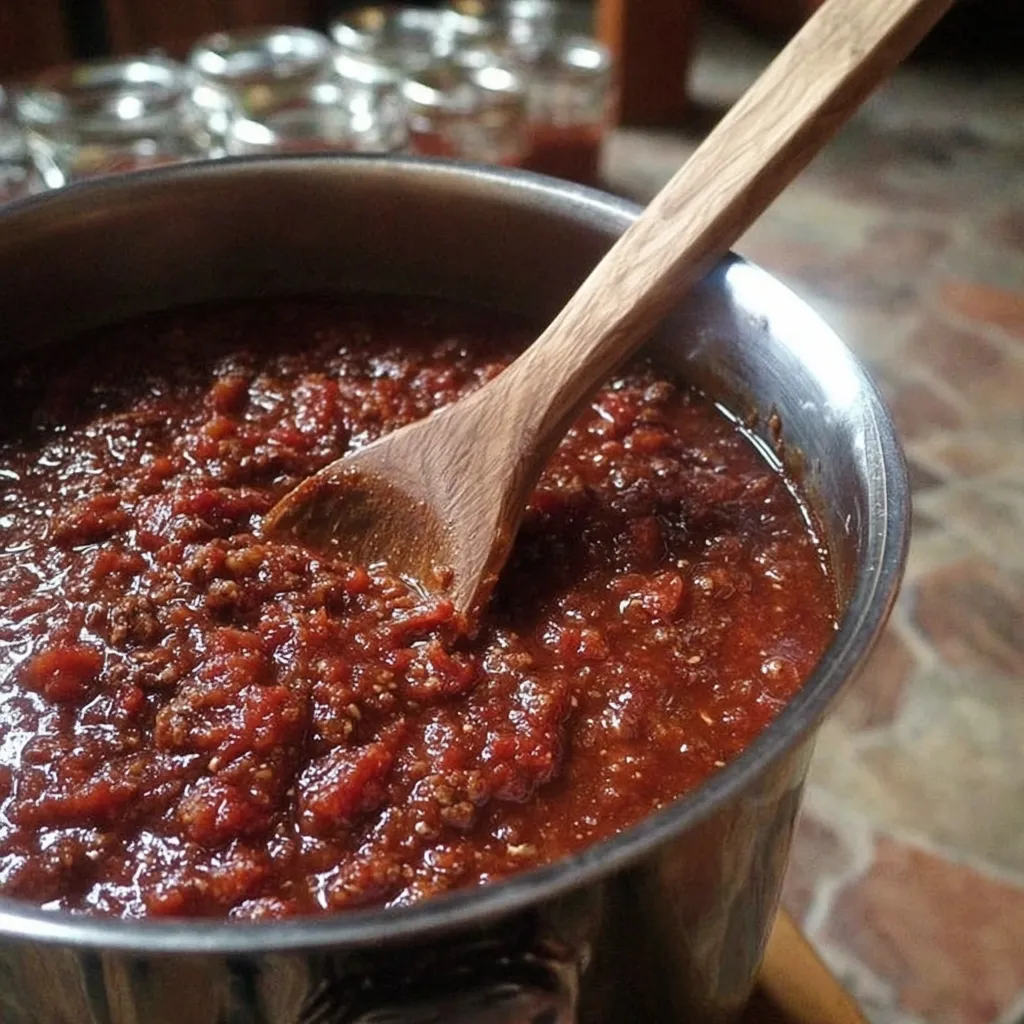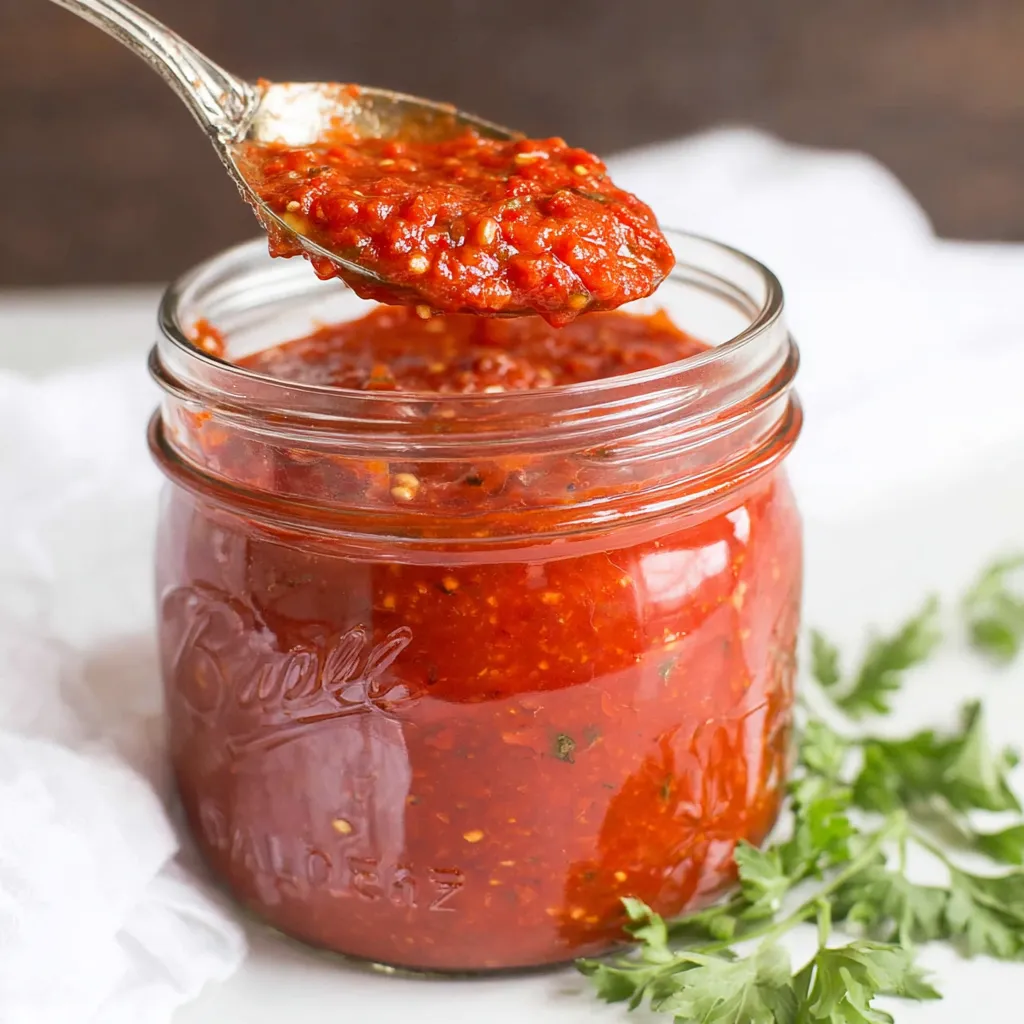Imagine the satisfaction of pulling a jar of vibrant, flavorful spaghetti sauce from your pantry on a cold winter evening, knowing you made it yourself with love and care. No more store-bought sauces filled with questionable ingredients! This guide will show you just how easy it is to create delicious, homemade, and safe-to-can Easy Homemade Spaghetti Sauce for Canning- Simple! Get ready to transform your kitchen into a sauce-making haven and enjoy the fruits (or rather, vegetables!) of your labor all year long.
Gathering Your Garden Goodness

Before we dive into the saucy goodness, let’s gather all the ingredients you’ll need. Don’t be intimidated by the list – it’s all about fresh, simple flavors that come together beautifully!
For the Spaghetti Sauce:
- Tomatoes: 25 lbs, Roma or other meaty varieties are ideal.
- Onions: 3 large, diced finely.
- Garlic: 8 cloves, minced. (More if you’re a garlic lover like me!)
- Olive Oil: 1/2 cup.
- Tomato Paste: 12 ounces (two 6-ounce cans).
- Dried Oregano: 2 tablespoons.
- Dried Basil: 2 tablespoons.
- Dried Thyme: 1 teaspoon.
- Sugar: 1/4 cup (or more, to taste, depending on the tomatoes’ acidity).
- Salt: 2 tablespoons (or to taste).
- Black Pepper: 1 teaspoon.
- Citric Acid: 1/4 teaspoon per pint jar OR 1/2 teaspoon per quart jar (for safe canning). This is important!
- Optional: Red Pepper Flakes: 1/2 teaspoon (for a little kick!).
Equipment You’ll Need:
- Large Stockpot or Dutch Oven: At least 12-quart capacity.
- Canning Jars: Pint or quart jars, with new lids and bands.
- Jar Lifter: Essential for safely removing hot jars.
- Wide-Mouth Funnel: Makes filling jars easier and cleaner.
- Canning Rack: For your water bath canner.
- Water Bath Canner: Large pot with a rack to submerge the jars.
- Large Bowls: For prepping vegetables.
- Ladle: For filling the jars.
- Clean Kitchen Towels: Lots of them!
- Food Mill or Blender (optional): For smoother sauce.
Step-by-Step to Spaghetti Sauce Nirvana
Alright, let’s get cooking! Don’t worry; I’ll guide you through each step, making it as simple and stress-free as possible. Remember, canning requires precision, so follow these instructions carefully.
Preparing the Tomatoes:
- Wash and core the tomatoes. You can peel them if you prefer a smoother sauce, but it’s not strictly necessary. A quick way to peel them is to blanch them in boiling water for 30-60 seconds, then plunge them into ice water. The skins will slip right off.
- Quarter the tomatoes.
Cooking the Sauce:
- In your large stockpot or Dutch oven, heat the olive oil over medium heat. Add the diced onions and cook until softened and translucent, about 5-7 minutes.
- Add the minced garlic and cook for another minute, until fragrant. Be careful not to burn the garlic!
- Add the quartered tomatoes to the pot. Bring to a simmer, then reduce the heat to low, cover, and cook for about 1-2 hours, stirring occasionally, until the tomatoes have broken down and softened considerably.
- If you prefer a smoother sauce, use an immersion blender to blend the sauce directly in the pot, or carefully transfer the sauce in batches to a regular blender or food mill. Be careful when blending hot liquids! Return the blended sauce to the pot.
- Stir in the tomato paste, dried oregano, dried basil, dried thyme, sugar, salt, and black pepper. If you’re using red pepper flakes, add them now too.
- Simmer the sauce, uncovered, for another 30-60 minutes, or until it reaches your desired consistency. Stir frequently to prevent sticking and burning. The longer it simmers, the richer the flavor will be.
- Taste and adjust seasonings as needed. You might want to add more sugar if your tomatoes are particularly acidic, or more salt and pepper to taste.
Preparing for Canning:
- While the sauce is simmering, prepare your canning jars. Wash them thoroughly in hot, soapy water and rinse well.
- Sterilize the jars by placing them in a boiling water bath for 10 minutes. Keep the jars hot until you’re ready to fill them. You can also sterilize them in the dishwasher if it has a sterilize cycle.
- Heat the canning lids in a small saucepan of simmering water. Do not boil! This softens the sealing compound.
Canning the Sauce:
- Remove the sterilized jars from the hot water, using your jar lifter. Place them on a clean kitchen towel-lined surface.
- Add the appropriate amount of citric acid to each jar: 1/4 teaspoon per pint jar OR 1/2 teaspoon per quart jar. This is CRUCIAL for ensuring the safe acidity level for canning.
- Using a wide-mouth funnel, ladle the hot spaghetti sauce into the hot jars, leaving 1/2 inch of headspace (the space between the sauce and the top of the jar).
- Remove any air bubbles by gently tapping the jars on the counter or using a non-metallic spatula to run along the inside of the jar.
- Wipe the rims of the jars with a clean, damp cloth to remove any spills or drips.
- Place a hot lid on each jar, and screw on the band until fingertip tight (not too tight, not too loose).
Processing in a Water Bath Canner:
- Place the filled jars in the canning rack of your water bath canner. Make sure the jars are not touching each other.
- Add enough hot water to the canner so that the water level is at least 1 inch above the tops of the jars.
- Bring the water to a rolling boil.
- Once boiling, process the jars for the recommended time:
- Pints: 35 minutes
- Quarts: 40 minutes
- (Adjust processing time for altitude – check your local extension office guidelines)
- Turn off the heat and let the jars sit in the hot water for 5 minutes before removing them. This helps prevent siphoning.
- Carefully remove the jars from the canner using your jar lifter and place them on a clean kitchen towel-lined surface, leaving space between the jars.
- Let the jars cool completely, undisturbed, for 12-24 hours. You should hear a “pop” as the jars seal.
Checking the Seals and Storing:
- After 12-24 hours, check the seals of the jars. The lids should be concave and not flex when pressed.
- If any jars did not seal, you can either reprocess them with new lids (within 24 hours) or store them in the refrigerator and use them within a week.
- Remove the bands from the sealed jars (this prevents rust).
- Label the jars with the date and contents.
- Store the canned spaghetti sauce in a cool, dark, and dry place. Properly canned spaghetti sauce can last for 12-18 months.
The Secret Ingredient: Love!
Okay, I know that sounds cheesy, but seriously, when you pour your heart into making something from scratch, it just tastes better! Plus, you control exactly what goes into your sauce, avoiding any artificial flavors, preservatives, or excessive sodium.
Tips and Tricks for Sauce Perfection
- Tomato Variety Matters: Roma or other meaty tomatoes are best because they have fewer seeds and less water, resulting in a thicker sauce.
- Roasting the Tomatoes: For an even deeper, richer flavor, try roasting the tomatoes before simmering. Toss them with olive oil, salt, pepper, and herbs, and roast at 400°F (200°C) until softened and slightly caramelized.
- Add Some Veggies: Feel free to add other vegetables to your sauce, such as bell peppers, zucchini, or carrots. Just dice them finely and sauté them along with the onions.
- Spice it Up: Experiment with different herbs and spices to customize your sauce to your liking. A bay leaf or a pinch of fennel seeds can add a wonderful depth of flavor.
- Acid is Key: Don’t skip the citric acid! It’s essential for ensuring the safe acidity level for canning.
- Headspace is Important: Leaving the correct amount of headspace is crucial for proper sealing. Too little headspace can cause the sauce to bubble out during processing, while too much headspace can prevent a good seal.
- Altitude Adjustments: If you live at a higher altitude, you’ll need to increase the processing time to ensure proper sealing. Check with your local extension office for specific recommendations.
Sauce Creations Beyond Spaghetti
While this sauce is fantastic on spaghetti (obviously!), don’t limit yourself! Use it as a base for lasagna, pizza, or even STUFFED PEPPERS. It’s also a fantastic shortcut when making CHICKEN SPAGHETTI, saving you so much time. You can also use it to make STUFFED SPAGHETTI SQUASH HEAVEN, CREAMY SAUSAGE PARMESAN DREAM, or even CREAMY PASTA SOUP HEAVEN. Think of it as your secret weapon for quick and easy weeknight meals. For a heartier sauce, consider using it as a base for a SUNDAY SLOW COOKER RAGU!
Troubleshooting Common Canning Concerns
- Siphoning (Liquid Loss During Processing): This can happen if the canner is overfilled with water, the jars are not properly vented, or the pressure fluctuates too much during processing. Ensure proper headspace, vent the jars well, and maintain a consistent boil.
- Cloudy Sauce: This is usually caused by minerals in your water or starch from the tomatoes. It’s generally safe, but you can reduce cloudiness by using filtered water.
- Jars Not Sealing: This can be caused by various factors, including improper headspace, damaged lids, or insufficient processing time. Make sure to follow the instructions carefully and use new lids for each batch.
Enjoy Your Homemade Harvest!
There you have it! Making your own Easy Homemade Spaghetti Sauce for Canning is a rewarding experience that will fill your pantry with delicious, homemade goodness. Once you’ve tasted the difference between store-bought and homemade, you’ll never go back! So, gather your ingredients, put on some music, and get ready to create some saucy magic. Happy canning!
Why is citric acid so important when canning spaghetti sauce?
Citric acid is crucial for ensuring the safe acidity level for canning. It helps prevent the growth of harmful bacteria.
What kind of tomatoes are best to use for this spaghetti sauce recipe?
Roma or other meaty varieties are ideal because they have fewer seeds and less water, resulting in a thicker sauce.
How long will the canned spaghetti sauce last?
Properly canned spaghetti sauce can last for 12-18 months when stored in a cool, dark, and dry place.
What does it mean if my spaghetti sauce is cloudy after canning?
Cloudy sauce is usually caused by minerals in your water or starch from the tomatoes and is generally safe to consume. Using filtered water can help reduce cloudiness.

Canned Spaghetti Sauce Magic
Ingredients
Equipment
Method
- Wash and core the tomatoes. Peel if desired by blanching in boiling water for 30-60 seconds, then plunging into ice water. Quarter the tomatoes.
- In a large stockpot or Dutch oven, heat the olive oil over medium heat. Add the diced onions and cook until softened and translucent, about 5-7 minutes.
- Add the minced garlic and cook for another minute, until fragrant, being careful not to burn it.
- Add the quartered tomatoes to the pot. Bring to a simmer, then reduce the heat to low, cover, and cook for about 1-2 hours, stirring occasionally, until the tomatoes have broken down and softened considerably.
- If desired, use an immersion blender to blend the sauce directly in the pot, or carefully transfer the sauce in batches to a regular blender or food mill. Be extremely careful when blending hot liquids. Return the blended sauce to the pot.
- Stir in the tomato paste, dried oregano, dried basil, dried thyme, sugar, salt, and black pepper. Add red pepper flakes if using.
- Simmer the sauce, uncovered, for another 30-60 minutes, or until it reaches your desired consistency. Stir frequently to prevent sticking and burning. The longer it simmers, the richer the flavor will be.
- Taste and adjust seasonings as needed, adding more sugar if the tomatoes are particularly acidic, or more salt and pepper to taste.
- While the sauce is simmering, prepare the canning jars. Wash them thoroughly in hot, soapy water and rinse well.
- Sterilize the jars by placing them in a boiling water bath for 10 minutes. Keep the jars hot until ready to fill. Alternatively, sterilize in the dishwasher with a sterilize cycle.
- Heat the canning lids in a small saucepan of simmering water. Do not boil.
- Remove the sterilized jars from the hot water using a jar lifter. Place them on a clean kitchen towel-lined surface.
- Add the appropriate amount of citric acid to each jar: 1/4 teaspoon per pint jar OR 1/2 teaspoon per quart jar. This is crucial for safe canning.
- Using a wide-mouth funnel, ladle the hot spaghetti sauce into the hot jars, leaving 1/2 inch of headspace (the space between the sauce and the top of the jar).
- Remove any air bubbles by gently tapping the jars on the counter or using a non-metallic spatula to run along the inside of the jar.
- Wipe the rims of the jars with a clean, damp cloth to remove any spills or drips.
- Place a hot lid on each jar, and screw on the band until fingertip tight (not too tight, not too loose).
- Place the filled jars in the canning rack of the water bath canner, ensuring the jars are not touching each other.
- Add enough hot water to the canner so that the water level is at least 1 inch above the tops of the jars.
- Bring the water to a rolling boil.
- Once boiling, process the jars for the recommended time: Pints: 35 minutes, Quarts: 40 minutes. (Adjust processing time for altitude – check local extension office guidelines).
- Turn off the heat and let the jars sit in the hot water for 5 minutes before removing them. This helps prevent siphoning.
- Carefully remove the jars from the canner using a jar lifter and place them on a clean kitchen towel-lined surface, leaving space between the jars.
- Let the jars cool completely, undisturbed, for 12-24 hours. Listen for a “pop” as the jars seal.
- After 12-24 hours, check the seals of the jars. The lids should be concave and not flex when pressed.
- If any jars did not seal, reprocess them with new lids (within 24 hours) or store them in the refrigerator and use them within a week.
- Remove the bands from the sealed jars (this prevents rust).
- Label the jars with the date and contents.
- Store the canned spaghetti sauce in a cool, dark, and dry place. Properly canned spaghetti sauce can last for 12-18 months.




